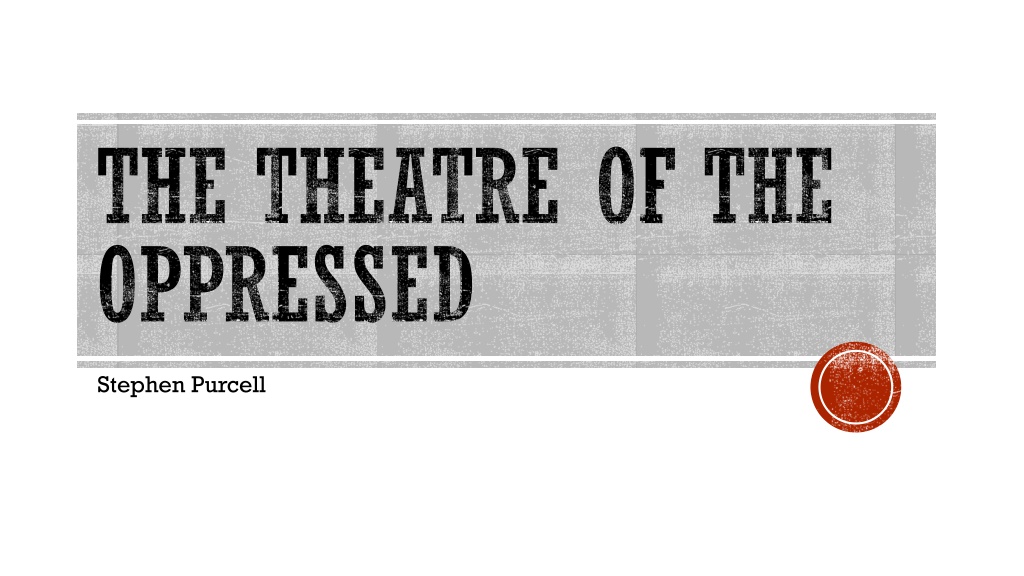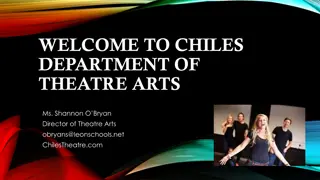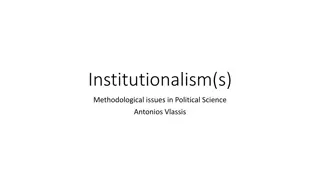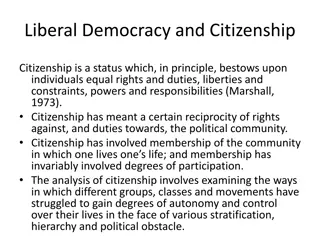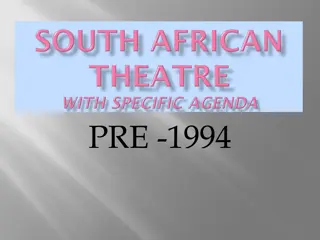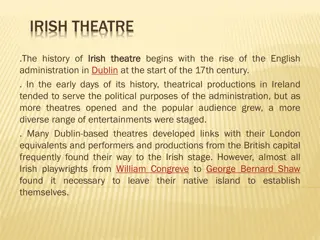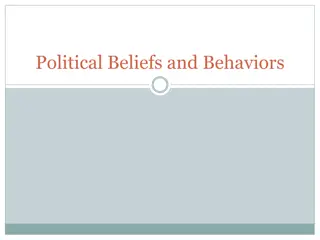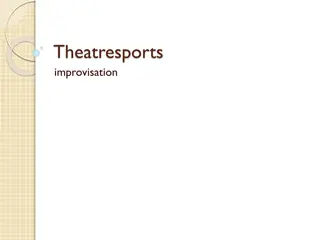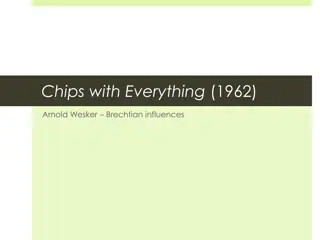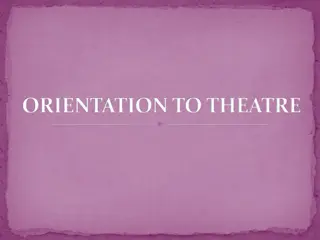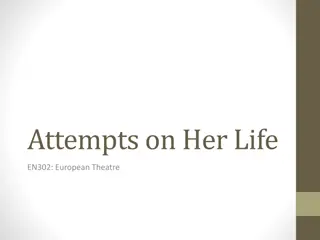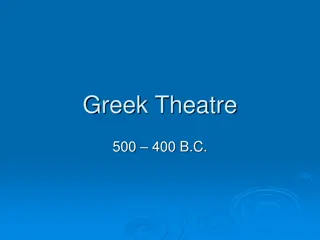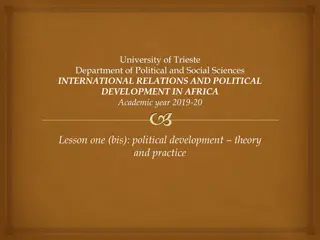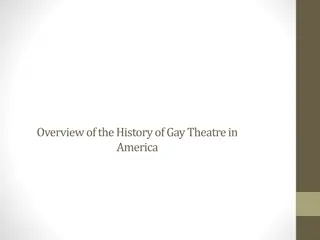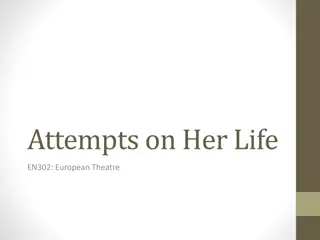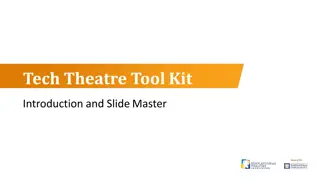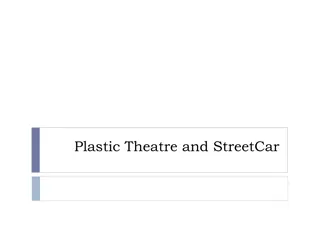Evolution of Theatre: From Dithyrambic Song to Political Theatre
The evolution of theatre from communal dithyrambic song to structured performances with Aristotelian influence, along with the revolutionary practices of Augusto Boal in creating a theatre for the people. Explore the origins, philosophies, and techniques that have shaped the art of theatre over centuries.
Download Presentation

Please find below an Image/Link to download the presentation.
The content on the website is provided AS IS for your information and personal use only. It may not be sold, licensed, or shared on other websites without obtaining consent from the author. Download presentation by click this link. If you encounter any issues during the download, it is possible that the publisher has removed the file from their server.
E N D
Presentation Transcript
THE THEATRE OF THE OPPRESSED Stephen Purcell
AUGUSTO BOAL (1931-2009) 1931: born in Rio de Janeiro, Brazil 1956-71: directed at the Arena Theatre, S o Paulo, Brazil 1964: a coup d etat and military dictatorship radically changed Brazilian society, forcing Boal to develop new techniques for political theatre (e.g. invisible theatre) 1971: imprisoned and tortured by the regime, following which he was forced into exile in Peru and Argentina 1973: developed theatre techniques as part of an effort to eliminate illiteracy in Peru; wrote The Theatre of the Oppressed 1986: returned to Brazil following the end of the dictatorship 1993-7: elected to the city council of Rio de Janeiro and developed legislative theatre
BOAL ON THEATRES ORIGINS Theatre was the people singing freely in the open air; the theatrical performance was created by and for the people, and could thus be called dithyrambic song. It was a celebration in which all could participate freely. Then came the aristocracy and established divisions: some persons will go to the stage and only they will be able to act; the rest will remain seated, receptive, passive these will be the spectators, the masses, the people. And in order that the spectacle may efficiently reflect the dominant ideology, the aristocracy established another division: some actors will be protagonists (aristocrats) and the rest will be the chorus symbolising, in one way or another, the mass. Aristotle s coercive system of tragedy shows us the workings of this type of theatre. (2008: xxiii)
ARISTOTLES POETICS (C. 350 BC) Earliest known work of dramatic criticism (unless one counts The Frogs by Aristophanes) The surviving parts of the Poetics focus on Tragedy and Epic Poetry Note chronology Aristotle was writing analytically, reflecting on tragedies he admired, not prescriptively
ARISTOTLE ON CATHARSIS Tragedy, then, is an imitation of an action that is serious, complete, and of a certain magnitude; in language embellished with each kind of artistic ornament, the several kinds being found in separate parts of the play; in the form of action, not of narrative; through pity and fear effecting the proper purgation [catharsis] of these emotions. (Part VI) Fear and pity may be aroused by spectacular means; but they may also result from the inner structure of the piece, which is the better way, and indicates a superior poet. For the plot ought to be so constructed that, even without the aid of the eye, he who hears the tale told will thrill with horror and melt to pity at what takes place. (Part XIV)
PERIPETEIA AND ANAGNORISIS the most powerful elements of emotional interest in Tragedy Peripeteia or Reversal of the Situation, and Recognition scenes [Anagnorisis] are parts of the plot. (Part VI) Reversal of the Situation is a change by which the action veers round to its opposite, subject always to our rule of probability or necessity. (Part XI) Recognition, as the name indicates, is a change from ignorance to knowledge, producing love or hate between the persons destined by the poet for good or bad fortune. The best form of recognition is coincident with a Reversal of the Situation, as in the Oedipus. [ ] This recognition, combined with Reversal, will produce either pity or fear; and actions producing these effects are those which, by our definition, Tragedy represents. (Part XI)
HAMARTIA For Aristotle, a tragic protagonist must be a man who is not eminently good and just, yet whose misfortune is brought about not by vice or depravity, but by some error or frailty [hamartia]. (Part XIII) The change of fortune should be not from bad to good, but, reversely, from good to bad. It should come about as the result not of vice, but of some great error or frailty, in a character either such as we have described, or better rather than worse. (Part XIII)
BOAL ON ARISTOTLE The first chapter of The Theatre of the Oppressed is on Aristotle s coercive system of tragedy : The tragic hero appears. The public establishes a kind of empathy with him. Surprisingly, the hero shows a flaw in his behaviour, a hamartia; and even more surprising, one learns that it is by virtue of this same hamartia that the hero has come to his present state of happiness. Through empathy, the same hamartia that the spectator may possess is stimulated, developed, activated. Suddenly, something happens that changes everything. This is what the Poetics classifies as peripeteia, a radical change in the character's destiny. The spectator, who up to then had his own hamartia stimulated, starts to feel a growing fear. The character is now on the way to misfortune. (2008: 32-3)
BOAL ON ARISTOTLE the tragic character must also pass through what Aristotle calls anagnorisis that is, through the recognition of his flaw as such and, by means of reasoning, the explanation of it. The hero accepts his error, hoping that, emphatically, the spectator will also accept as bad his own hamartia. But the spectator has the great advantage of having erred only vicariously: he does not really pay for it. Finally, so that the spectator will keep in mind the terrible consequences of committing the error not just vicariously but in actuality, Aristotle demands that tragedy have a terrible end, which he calls catastrophe. (2008: 33)
BOAL ON ARISTOTLE Those three interdependent elements (peripeteia, anagnorisis, catastrophe) have the ultimate goal of provoking catharsis in the spectator [the spectator] suffers a blow with regard to his fate (the action of the play), recognises the error vicariously committed and is purified of the antisocial characteristic which he sees in himself (2008: 33-4) [Aristotle] tells us that poetry, tragedy, theatre have nothing to do with politics. But reality tells us something else. all of man s activities including, of course, all the arts, especially theatre are political. And theatre is the most perfect artistic form of coercion. (2008: 33-4)
BOAL ON ARISTOTLE Aristotle s coercive system of tragedy survives to this day, thanks to its great efficacy. It is, in effect, a powerful system of intimidation. The structure of the system may vary in a thousand ways, making it difficult at times to find all the elements of its structure, but the system will nevertheless be there, working to carry out its basic task: the purgation of all antisocial elements. Precisely for that reason, the system cannot be utilized by revolutionary groups during revolutionary periods. That is, while the social ethos is not clearly defined, the tragic scheme cannot be used, for the simple reason that the character s ethos will not find a clear social ethos that it can confront. (2008: 40) His system appears in disguised form on television, in the movies, in the circus, in the theatres. It appears in many and varied shapes and media. But its essence does not change: it is designed to bridle the individual, to adjust him to what pre-exists. (2008: 41-2)
BOAL ON ARISTOTLE It should be noted that Boal s reading of Aristotle is not without its critics. Paul Dwyer argues that Boal offers an oversimplified view of the relations between theatre, theory, and the state in Ancient Greece (2005: 636): His critique of Aristotle is dogged from the outset by two overriding problems: (a) he hardly distinguishes between, on the one hand, Aristotle s ideal model of tragedy and, on the other hand, the evidence we have of plays as actually written and performed; (b) he glosses over the very significant differences between Aristotle and whatever Aristotelianisms have followed. (2005: 637)
BOAL AND BRECHT Boal contrasts Aristotle with a much more recent theorist of theatre: Aristotle proposes a poetics in which the spectator delegates power to the dramatic character so that the latter may act and think for him. Brecht proposes a poetics in which the spectator delegates power to the character who thus acts in his place but the spectator reserves the right to think for himself, often in opposition to the character. (2008: 97)
BERTOLT BRECHT (1898-1956) 1898: born in in Augsburg, Bavaria 1926: started to study Marxism and to write a number of socially critical plays 1927: first of many collaborations with composer Kurt Weill 1930-33: wrote a series of learning plays , or Lehrst cke, and began to develop his concept of epic theatre 1933: left Germany very shortly after Hitler s rise to power; his plays were banned by the Nazis 1941: after several years in exile in Denmark, Sweden and Finland, he moved to the USA, where he lived and worked in Hollywood 1949: returned to East Germany
BRECHTIAN THEATRE Brecht s aim was to find a style of theatre which would make the spectator adopt an attitude of inquiry and criticism (1977: 136). As he argued in his Short Organum for the Theatre (1949): The theatre as we know it shows the structure of society (represented on the stage) as incapable of being influenced by society (in the auditorium). Shakespeare s great solitary figures, bearing on their breast the star of their fate, carry through with irresistible force their futile and deadly outbursts; they prepare their own downfall; life, not death, becomes obscene as they collapse; the catastrophe is beyond criticism. (1977: 189) Brecht felt that conventional theatre audiences were dangerously passive: They scarcely communicate with each other; their relations are those of a lot of sleepers. True, their eyes are open, but they stare rather than see, just as they listen rather than hear. They look at the stage as if in a trance. (1977: 187)
BRECHTIAN THEATRE Brecht contrasted such spectators those of the dramatic theatre with those of his own epic theatre, which was designed to agitate and unsettle: The dramatic theatre s spectator says: Yes, I have felt like that too Just like me It s only natural It ll never change The sufferings of this man appal me, because they are inescapable That s great art; it all seems the most obvious thing in the world I weep when they weep, I laugh when they laugh. The epic theatre s spectator says: I d never have thought it That s not the way That s extraordinary, hardly believable It s got to stop The sufferings of this man appal me, because they are unnecessary That s great art: nothing obvious in it I laugh when they weep, I weep when they laugh. (1977: 71)
BRECHTIAN THEATRE (Brecht 1977: 37)
BRECHTIAN THEATRE For art to be un-political means only to ally itself with the ruling group. (Brecht 1977: 196). We ask you expressly to discover That what happens all the time is not natural. For to say that something is natural In such times of bloody confusion Of ordained disorder, of systematic arbitrariness Of inhuman humanity is to Regard it as unchangeable. (The Exception and the Rule, p. 37) Compare Boal: This book attempts to show that all theatre is necessarily political, because all the activities of man are political and theatre is one of them. (Boal 2008: xxiii)
BOAL ON BRECHT Brecht s poetics is that of the enlightened vanguard: the world is revealed as subject to change, and the change starts in the theatre itself, for the spectator does not delegate power to the characters to think in his place, although he continues to delegate power to them to act in his place. (2008: 135) The poetics of the oppressed is essentially the poetics of liberation: the spectator no longer delegates power to the characters either to think or to act in his place. The spectator frees himself; he thinks and acts for himself! (2008: 135)
BOALS TECHNIQUES In this week s set reading, Boal outlines four stages by which he turns the spectator into an actor: 1: Knowing the body 2: Making the body expressive 3: The theatre as language: Simultaneous dramaturgy Image theatre Forum theatre 4: The theatre as discourse
1: KNOWING THE BODY the theatrical experience should begin not with something alien to the people (theatrical techniques that are taught or imposed) but with the bodies of those who agree to participate in the experiment. (2008: 103) Bodies are inscribed by political structures: The exercises of this first stage are designed to undo the muscular structure of the participants. That is, to take them apart, to study and analyse them. Not to weaken or destroy them, but to raise them to the level of consciousness. (2008: 104)
2: MAKING THE BODY EXPRESSIVE A series of games can help the participants to begin to use their bodily resources for self-expression. (2008: 106) For example, doing physical impersonations of animals or occupations: If the participants depict an animal, it will perhaps have little to do with their ideology. But if a peasant is called upon to act as a landlord; a worker, the owner of a factory; or if a woman must portray a policeman, all their ideology counts and finds physical expression through the game. (2008: 108)
3: THEATRE AS LANGUAGE Simultaneous dramaturgy:actors perform a short scene on a theme proposed by a spectator; actors stop the performance at crisis point and ask audience for suggestions. They improvise immediately all the suggested solutions, and the audience has the right to intervene, to correct the actions or words of the actors, who are obligated to comply strictly with these instructions from the audience. Thus, while the audience writes the work the actors perform it simultaneously. (2008: 109) Image theatre: Here the spectator has to participate more directly. The participant is asked to express his opinion, but without speaking, using only the bodies of the other participants and sculpting with them a group of statues, in such a way that his opinions and feelings become evident. When finally an image is arrived at that is the most acceptable to all, then the spectator-sculptor is asked to show the way he would like the given theme to be; that is, in the first grouping the actual image is shown, in the second the ideal image. Finally he is asked to show a transitionalimage, to show how it would be possible to pass from one reality to the other. (2008: 112)
3: THEATRE AS LANGUAGE: FORUM THEATRE Forum theatre is among the best known of Boal s techniques. The procedure is as follows: First, the participants are asked to tell a story containing a political or social problem of difficult solution. Then a 10- or 15-minute skit portraying that problem and the solution intended for discussion is improvised or rehearsed, and subsequently presented. When the skit is over, the participants are asked if they agree with the solution presented. At least some will say no. At this point it is explained that the scene will be performed once more, exactly as it was the first time. But now any participant in the audience has the right to replace any actor and lead the action in the direction that seems to him most appropriate. (2008: 117)
3: THEATRE AS LANGUAGE: FORUM THEATRE Here is a demonstration of Forum Theatre by the UK-based theatre company Cardboard Citizens, here working with ESOL (English for Speakers of Other Languages) learners in Bow, London: https://www.youtube.com/watch?v=0LdIUGJcoAE&t=0h6m34s (stop at 9.41) In the forum theatre no idea is imposed: the audience, the people, have the opportunity to try out all their ideas, to rehearse all the possibilities, and to verify them in practice, that is, in theatrical practice. It is not the place of the theatre to show the correct path, but only to offer the means by which all possible paths may be examined. (2008: 119)
4: THEATRE AS DISCOURSE In this week s set reading, Boal gives several examples of these simple forms in which the spectator-actor creates spectacles according to his need to discuss certain themes or rehearse certain actions (2008: 102), so I will not outline them all here. Some indicative examples: Invisible theatre: This is performed in public in such a way that spectators do not realise they are watching a performance; the space of performance is turned into a public forum , Breaking of repression: The technique of breaking repression consists in asking a participant to remember a particular moment when he felt especially repressed, accepted that repression, and began to act in a manner contrary to his own desires. Once the reproduction of the actual event is over, the protagonist is asked to repeat the scene, but this time without accepting the repression, fighting to impose his will, his ideas, his wishes. (2008: 129)
4: THEATRE AS DISCOURSE Newspaper Theatre: This is a means of estranging news stories that spectators might otherwise take at face value. It consists of several simple techniques for transforming daily news items, or any other non-dramatic material, into theatrical performances , such as detaching a story from the format which makes it false or tendentious , alternating two news items so as to throw light on each other, or adding complementary information that exposes it (2008: 121). Here s a clip of Cardboard Citizens workshopping Newspaper Theatre with a different group: https://www.youtube.com/watch?v=KfRY1wTRrwA (stop at 1.44)
THE POLITICS OF BOALS THEATRE Maybe the theatre in itself is not revolutionary, but these theatrical forms are without a doubt a rehearsal of revolution. (2008: 119) Here the cathartical effect is entirely avoided. We are used to plays in which the characters make the revolution on stage and the spectators in their seats feel themselves to be triumphant revolutionaries. Why make a revolution in reality if we have already made it in the theatre? But that does not happen here: the rehearsal stimulates the practice of the act in reality. (2008: 120) In Boal stheatre, the spectator is freed from his chains, finally acts, and becomes a protagonist (2008: 121).
BOAL AND WANNS Wann s wrote Soiree for the 5th of June in 1967, a few years before Boal published Theatre of the Oppressed, so there is no direct borrowing from Boal s theories. Nonetheless, there are some correspondences: both were influenced by Brecht (Allen 1984: 107) for Wann s, the audience must learn to abandon its purely passive role (Allen 1984: 107, Allen s phrase) For Wann s's plays to achieve the effects which he wishes, substantial demands are put on the audience itself: to detach oneself, to ask questions and even to indulge in an impromptu dialogue with the stage. These are large demands, and experience thus far suggests that audiences are as yet untrained or unwilling to take on the task. Wann s obviously believes that Arab audiences have been responsive in the past and can be made to be so again. (Allen 1984: 113)
BOAL AND WANNS Soiree for the 5th of June was seen by 25,000 people on its initial run in Damascus. Actors were in the audience from the start, whipping up a sense of agitation. PRODUCER: Oh my, what a day! We didn t invite government officials to the show to listen to your silly stories. PRODUCER (spotting the Spectator approaching the stage and standing threateningly in his way): No, no, Sir! Please. This is total chaos, and we can t allow it. Drama has its rules that need to be respected. PRODUCER (exploding in rage as the Second Spectator comes on to the stage): Where are you going? Where are you going? Has the stage turned into a public forum? Have you forgotten where you are? The entire theater hall now comes to resemble a genuine meeting-place.
BOAL AND WANNS Apparently some spectators did not realize that the actors in the audience were indeed actors (though Wann s was surprised at this) (Allen 1984: 105). Does this make it an example of invisible theatre ? However, as Abdall h Ab H f pointed out: [Wann s] has admitted that placing actors in the audience or at the front of the auditorium achieved neither participation nor contact nor even dialogue. These were essentially artificial devices which were unable to establish an impromptu, warm or genuine dialogue between the stage and the audience, the two dimensions of the theatre. (quoted in Allen 1984: 106)
SPECTATOR: A BAD WORD? Boal s book comes to a clear conclusion: Yes, this is without a doubt the conclusion: Spectator is a bad word! The spectator is less than a man and it is necessary to humanise him, to restore to him his capacity of action in all its / fullness. (2008: 134-5) All these experiments of a people s theatre have the same objective the liberation of the spectator, on whom the theatre has imposed finished visions of the world. The spectators in the people s theatre (i.e., the people themselves) cannot go on being the passive victims of those images. (2008: 135)
SPECTATOR: A BAD WORD? The key theorist-practitioners of the 20th century tended, as Jacques Ranci re has pointed out, to see the kind of spectatorship associated with naturalism, cinema or television as a bad thing , equating it with intellectual, political or spiritual passivity. The most common conclusion runs as follows: Theatre involves spectatorship, and spectatorship is a bad thing. What must be pursued is a theatre without spectators, a theatre where spectators will no longer be spectators, where they will learn things instead of being captured by images and become active participants in a collective performance instead of being passive viewers. (2007: 272)
SPECTATOR: A BAD WORD? Ranci re identifies Bertolt Brecht s epic theatre and Antonin Artaud s theatre of cruelty as the most definitive examples of the two ways, antagonistic in principle , in which this has been understood: On the one hand the spectator must be confronted with the spectacle of something strange, which stands as an enigma and demands that he investigate the reason for that strangeness. On the other hand the spectator must be torn from his delusive mastery, drawn into the magical power of theatrical action, where he will exchange the privilege of playing the rational viewer for the experience of possessing theatre s true vital energies. (2007: 272). The project of reforming the theatre ceaselessly wavered between these two poles of distant inquiry and vital embodiment (2007: 272).
SPECTATOR: A BAD WORD? Ranci re argues that we must question the very footing on which those ideas are based , and queries the equivalence of seeing and passivity (2007: 274): The spectator is active, just like the student or the scientist: He observes, he selects, he compares, he interprets. He makes his poem with the poem that is performed in front of him. She participates in the performance if she is able to tell her own story about the story that is in front of her. (2007: 277). Spectatorship is not a passivity that must be turned into activity. It is our normal situation. We learn and teach, we act and know, as spectators who link what they have seen and told, done and dreamed. (2007: 279)
REFERENCES Allen, Roger (1984) Arabic Drama in Theory & Practice: The Writings of Sadall h Wann s , Journal of Arabic Literature, 15, pp. 94-113. Boal, Augusto (2008) The Theatre of the Oppressed, trans. Charles A. & Maria-Odilia Leal McBride & Emily Fryer, London: Pluto Press (first published 1979). Brecht, Bertolt (1977) Brecht on Theatre, trans. J. Willett, London: Eyre Methuen. Dwyer, Paul (2005) Theoria Negativa: Making Sense of Boal's Reading of Aristotle , Modern Drama, 48: 4, pp. 635-58. Ranci re, Jacques (2007) The Emancipated Spectator , Artforum 45: 7, pp. 271-80.
